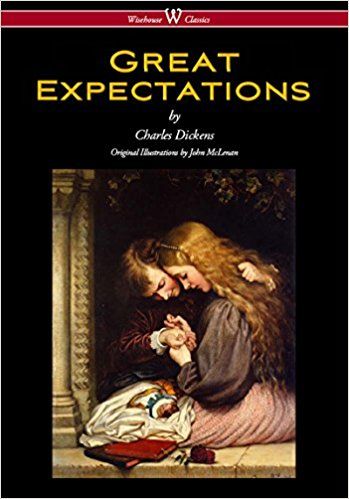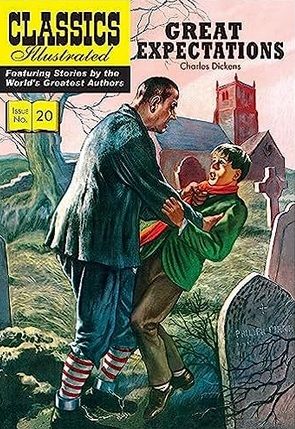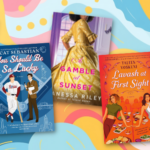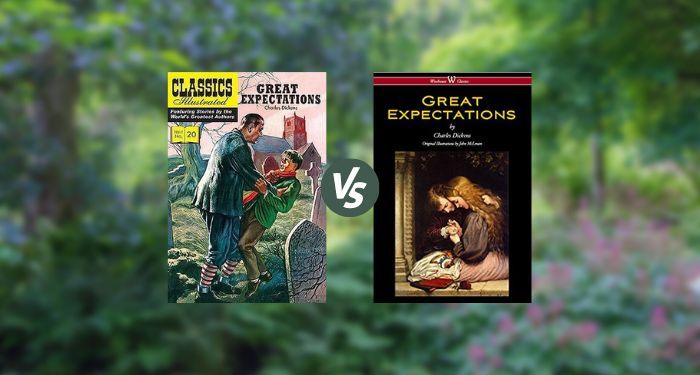
Comic Vs. Book: GREAT EXPECTATIONS
Everyone knows that books can be adapted into movies. It happens all the time. But did you know they can be adapted into graphic novels, too? In this series, I’ll be taking a look at classic novels and their illustrated counterparts to determine what each did well, what each did wrong, and how they approach the same story decades apart and in such different media.
If you’re in a good mood, knock it off because we’re looking at a typically depressing Dickensian offering: 1861’s Great Expectations!
Pip is a young orphan living with his abusive older sister and her husband, Joe. After nearly running afoul of an escaped convict, Pip makes a much more profitable acquaintance: Miss Havisham, a dictatorial old woman who never got over being jilted at the altar and now is “training” her adopted daughter Estella to break men’s hearts — including Pip’s — in vengeance. When Pip suddenly comes into a fortune from an anonymous benefactor, he assumes it is Miss Havisham, but no: it’s the convict who earned the money during his Australian exile.
Through a series of unfortunate events, Pip loses the fortune, Miss Havisham dies, and Estella marries a heartless man. Pip eventually gets back on his feet, even reuniting with a widowed, sadder-but-wiser, Estella.
The Book
So it turns out I hate Dickens! Who knew!
In fairness, it’s not entirely the book’s fault. Yes, it is very wordy, and there are several chapters where nothing much happens, and I found it very dull. (Incidentally, no, Dickens was not paid by the word, so that’s no excuse.) But part of my boredom stemmed from the book’s brilliance in one key aspect: the unforgettable Miss Havisham, who looms large over both the novel and the public imagination. Whenever she was not around, I was just waiting for her to come back.
It’s a lot like watching Psycho: Norman Bates has become such an icon that you spend the first 40 minutes of the film expecting the stabbing to begin rather than giving your full attention to the story. The film’s/book’s reputation has preceded it, to its detriment.
I do appreciate the general arc of the story. Pip gets a taste of wealth at Miss Havisham’s and can never, ever be satisfied with his old life as a blacksmith’s apprentice again. And I liked the touches of humor throughout, like when Pip goes to a play in which an old acquaintance performs and is heckled by the audience.
Then, there is the matter of the alternate ending. The published ending has Pip, now penniless, joining a friend in business and then finally getting together with Estella. But the original ending, which Dickens’s pal Edward Bulwer-Lytton (of “it was a dark and stormy night” fame) thought too depressing for some reason, had Pip and Estella meet one more time without any hope of romance between them.
Frankly, I don’t see what’s so catastrophic about this. Pip has found friends, reunited with his family, and established an independent, successful place in the world. Is his lack of romantic entanglements such a huge tragedy that it needs correcting?
(Unless, of course, Bulwer-Lytton was referring only to Estella’s fate, which certainly seems rosier in the edited ending. Is it possible that a Victorian man was that concerned about a fictional woman’s welfare?)
But, of course, the comic book adaptation includes the published ending, not the original.
The Comic
Classics Illustrated has been the standard-bearer for graphic novel adaptations for decades. My copy of Great Expectations is a reprint from that series, so it’s probably been cleaned up a bit since its original publication in 1947, but the original art style still shines through. This was adapted by an unknown writer and illustrated by Henry C. Kiefer.
It feels VERY truncated when you read it right after the novel. It’s only 50 pages, after all. Among many other things, it excludes the scene of Miss Havisham accidentally (?) getting lit on fire, which I guess they figured would be too much for little kids. More disappointingly, it also cuts Pip’s conflicted feelings for Joe, whose coarse ways come to embarrass him and prompt him to ungraciously cut off contact with his oldest and dearest friend. That was one of my favorite elements from the novel, so I was sad not to see it here.
The art is good for the period but a little stiff by modern standards. The coloring on Miss Havisham is especially effective, with pale yellows and blues that show how much of a ghost she has become in her own life. As usual, Miss Havisham steals the show!
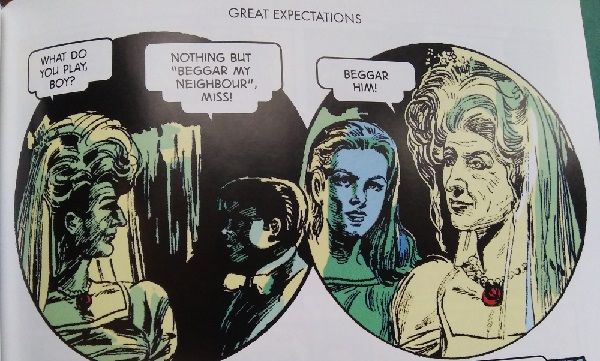
The Takeaways
If you really love Dickens, then obviously you will prefer the original. But for those of us not inclined towards slow-moving, 500-page Victorian novels, the adaptation is good enough. Still, I feel like there has to be a happy medium between 500 pages and 50.
The comic is probably the better way to introduce the young and/or the impatient to the story, despite all the cuts. On the other hand, my introduction to Great Expectations was my mother reading it out loud to me and having to stop every other sentence to explain what the words meant. That probably explains a lot about me.
Check out previous Comic vs. Book showdowns: To Kill a Mockingbird, The Hobbit, and Treasure Island



